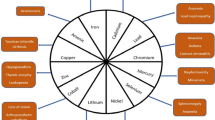Abstract
This paper examines the effects of heavy metals on microorganisms in the aqueous environment; the mechanisms by which metals may exert toxic effects on microbes and the factors affecting microbial response to metals; the ways in which microbial activity may alter the metal balance of an environment and the modifications produced in microbes by heavy metal ions; the effects of the toxic copper ion on the growth, respiration, magnesium content, cytochrome synthesis and osmotic sensitivity of some organisms studied in the laboratory; and the feasibility of the participation of microbes in geochemical processes considering the demonstrable resistance to toxic metals by some bacteria and the fact that natural environments may contain high levels of metals rendered less toxic by binding to natural chelating compounds.
Zusammenfassung
In dieser Arbeit werden verschiedene Wirkungen von Schwermetallen auf Mikroorganismen in wäßrigem Milieu untersucht. Es wird gezeigt, daß Schwermetalle toxische Wirkungen auf Mikroorganismen ausüben können und welche Faktoren die Reaktionen von Mikroben gegenüber Metallen bestimmen. Weiter wird beschrieben, wie die Mikrobenaktivität das Metallgleichgewicht in einem gegebenen Milieu verändern und beeinflussen kann und wie andererseits Änderungen in den Mikroben selbst durch Schwermetall-Ionen hervorgerufen werden. Dabei wird besonders die Wirkung des toxischen Kupfer-Ions auf das Wachstum, die Atmung, den Magnesiumgehalt, die Cytochromsynthese und die osmotische Empfindlichkeit einiger Mikroorganismen dargestellt. Die Anwesenheit von Mikroben bei geochemischen Prozessen wird unter Berücksichtigung der Resistenz einiger Bakterien gegenüber toxischen Metall-Ionen diskutiert. Dabei spielt die Tatsache eine große Rolle, daß durch Chelatbildung die Schwermetall-Ionen in der natürlichen Umwelt der Mikroorganismen ihre toxische Wirkung verlieren.
Similar content being viewed by others
Selected References
General
Porter, J. R.: Bacterial Chemistry and Physiology. New York: Wiley, 1073 p., 1946.
Thimann, K. V.: The Life of Bacteria. New York: Macmillan 775 p., 1963.
Inhibition of Microorganisms by Heavy Metals
Hewitt, E. J., and D. J. D. Nicholas: Cations and Anions: Inhibitions and interactions in metabolism and in enzyme activity. In: Metabolic Inhibitors, Vol. 2. (Eds. R. M. Hocheter and J. H. Quastel) p. 311–436. New York: Academic Press, 753 p., 1963.
Effects of Metal Toxicity
Healy, W. B., S. Cheng, and W. D. McElroy: Metal toxicity and iron deficiency effects on enzymes in Neurospora. Arch. Biochem. Biophys. 54, 206–214 (1955).
Renshaw, E. C., B. Rosenberg, and L. Van Camp: Platinum induced filamentous growth in Escherichia coli. Bact. Proc. p. 74, (1966).
Weed, L. L., and D. Longfellow: Morphological and biochemical changes induced by copper in a population of Escherichia coli. J. Bacteriol. 67, 27–33 (1954).
Mechanism of Metal Toxicity
Abelson, P. H., and E. Aldous: Ion antagonisms in microorganisms: Interference of normal magnesium metabolism by nickel, cobalt, cadmium, zinc and manganese. J. Bacteriol. 60, 401–413 (1950).
Danielli, J. F., and J. T. Davies: Reactions at interfaces in relation to biological problems. Advan. Enzymol. 11, 35–89 (1949).
Healy, W. B., S. Cheng, and W. D. McElroy: Metal toxicity and iron deficiency effects on enzymes in Neurospora. Arch. Biochem. Biophys. 54, 206–214 (1955).
Jones, J. R. E.: A further study of the relation between toxicity and solution pressure, with Polycelis nigra as test animal. J. Exptl. Biol. 17, 408–415 (1940).
Mathews, A. P.: Relation between solution pressure, atomic volume, and physiological effects of the elements. Am. J. Physiol. 10, 290–323 (1904).
Neyland, M., P. Dunkel, and A. L. Schade: The uptake of cobalt by Proteus vulgaris. J. Gen. Microbiol. 7, 409–416 (1952).
Shaw, W. H. R.: Cation toxicity and the stability of transition-metal complexes. Nature 192, 754–755 (1961).
Somers, E.: Fungitoxicity of metal ions. Nature 184, 475–476 (1959).
— The fungitoxicity of metal ions. Ann. Appl. Biol. 49, 246–253 (1961).
Modifications of the Environment1. Metal Binding Compounds
Albert, A.: Selective Toxicity. London: Methuen, 394 p., 1965.
Khailov, K. M.: The formation of organometallic complexes with the participation of external metabolites of marine algae. Dokl. Akad. Nauk. S.S.S.R. 155, 933–936 (1964).
Pratt, D.: Growth inhibitory action of copper for Mycobacterium phlei. J. Bacteriol. 65, 157–159 (1953).
Schade, A. L.: Cobalt and bacterial growth, with special reference to Proteus vulgaris. J. Bacteriol. 58, 811–822 (1949).
Temple, K. L., and N. M. Le Roux: Syngenesis of sulfide ores: sulfate-reducing bacteria and copper toxicity. Econ. Geol. 59, 271–278 (1964).
Toyoda, S.: Pathway of carbohydrate breakdown in Alternaria kikuchiana and the selective toxicity of copper compounds to this fungus. Chem. Abstr. 63, 18706 (1965).
Modifications of the Environment2. Ion Interactions
Abelson, P. H., and E. Aldous: Ion antagonisms in microorganisms: interference of normal magnesium metabolism by nickel, cobalt, cadmium, zinc and manganese. J. Bacteriol. 60, 401–413 (1950).
Adiga, P. R., K. S. Sastry, V. Venkatasurbramanyam, and P. S. Sarma: Interrelationships in trace-element metabolism in Aspergillus niger. Biochem. J. 81, 545–550 (1961).
Chester, V. E.: The role of calcium in the increase in flocculence of yeast growing in the presence of copper. Proc. Roy. Soc. (London), Ser. B. 1962: 555–566 (1965).
MacLeod, R. A., and E. E. Snell: The relation of ion antagonism to the inorganic nutrition of lactic acid bacteria. J. Bacteriol. 59, 783–792 (1950).
Modifications of Organisms
Ashida, J.: Adaptation of fungi to metal toxicants. Ann. Rev. Phytopathol. 3, 153–174 (1965).
Golomzik, A. I., and V. I. Ivanov: Adaptation of Thiobacillus ferrooxidans to increased concentrations of hydrogen and iron ions. Mikrobiologiya 34, 465–468 (1965).
Kikuchi, T.: Studies on the pathway of sulfide production in a copper-adapted yeast. Plant Cell Physiol. (Tokyo) 6, 195–210 (1965).
Neyland, M., P. Dunkel, and A. L. Schade: The uptake of cobalt by Proteus vulgaris. J. Gen. Microbiol 7, 409–416 (1952).
Author information
Authors and Affiliations
Rights and permissions
About this article
Cite this article
Sadler, W.R., Trudinger, P.A. The inhibition of microorganisms by heavy metals. Mineral. Deposita 2, 158–168 (1967). https://doi.org/10.1007/BF00201912
Issue Date:
DOI: https://doi.org/10.1007/BF00201912




